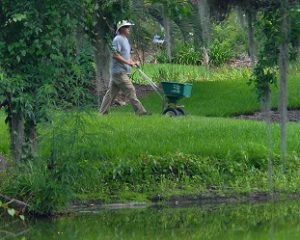By Christine Kelly-Begazo, Indian River County Agriculture Extension Agent and Josh Kutyna, Extension office Program Assistant

As most of us know by now, Indian River County has enacted a fertilization ban which runs from June 1st – September 30th. With the ban being lifted for the next 8 months those of us that have lawns requiring fertilizer can now do so legally. Before dragging out those fertilizer bags there are some important guidelines to follow. Just because you can fertilize your lawn, does not necessarily mean that you should. Each lawn is different and special care and attention needs to be taken in-order to create and maintain a healthy turf. There are several fertilization rules that remain in effect regardless of whether there is a ban or not, and abiding by them contributes greatly to the preservation and purity of our local water resources. For example, many people aren’t aware that you cannot apply fertilizer when a flood/ tropical storm/ hurricane watch or warning is in effect for ANY part of the county. Nor can you apply when rainfall is expected to exceed two inches within a 24-hour period. For a full run-down on the fertilizer ban in our area and its’ additional requirements and special exemptions, follow this link: http://ircstormwater.com/fertilizer.htm . Once you’re caught up with our local ordinance, follow the simple guidelines below to get started:
Do’s:
- Apply fertilizer ONLY on turfgrass that is actively growing, not when a lawn is dormant. In some parts of the state, turf growth is dormant for many months during the fall and winter when nighttime temperatures are consistently below 60o Fertilizer applied when grass is not growing wastes your time and money since it will not be beneficially used by the grass. Instead, it can leach through the soil or run off and possible pollute nearby water bodies. In our area, lawns generally should not be fertilized after October or before April.
- To determine what fertilization program is needed for your lawn, you should first start with a soil test. It is important to know the pH of your soil and what nutrients are already available to the plants. Consult your local

It’s important to be especially careful when applying fertilizer near a water source. Use a drop feeder so particles aren’t getting tossed outside of the application zone. county extension office for help if unsure how to proceed with this step.
- Purchase a fertilizer containing nutrients that are slow-release in nature. They have less potential to wind up in our waterways and lawns are less like to promote erratic growth surges when using them.
- Ready to apply? It is very important to understand the label on the fertilizer bag, the % of each nutrient contained in that bag and the form that it comes in. The three numbers on the front of a bag of fertilizer represent the percentage of Nitrogen-Phosphorus-Potassium (N-P-K) that is contained within that bag. A bag that reads 12-0-4 would contain 12% Nitrogen, 0% Phosphorus and 4% Potassium.
- Your fertilizer must contain at least 30% slow-release nitrogen, and you can apply up to 1 lb of nitrogen per 1,000 sq ft.
- Follow this link: https://ffl.ifas.ufl.edu/handbook/Fertilize_Appropriately.pdf and consult Table 1 to determine the nitrogen needs for your species of turfgrass. Next, use Table 2 for calculating the total amount of fertilizer you need to apply based on the slow-release nitrogen content of your bag.
Don’ts:
- Be careful not to spill fertilizer. DO NOT hose away spilled fertilizer, take a little extra time to sweep up the granules to avoid them going down a storm drain.
- Use a drop spreader as opposed to a rotary one. Drop spreaders distribute particles where you want them, while rotary spreaders could toss the fertilizer into undesired places.
- Avoid the use of 2-in-1 herbicide-fertilizers, such as ‘weed and feed’ products. Tree and shrub roots can extend into your lawns grass roots, and the herbicides can harm them leading to a quicker decline.
Above all else, preventing pollution is the most important part of applying any fertilizer to a property. Just the right amount can sustain a healthy lawn and allow for a denser root system that can filter impurities from leachate or runoff. On the other hand, too much fertilizer can stimulate uncontrolled growth that can be detrimental to the turf during the winter. Not to mention that the unutilized fertilizer can potentially seep past the root zone and into our groundwater or be taken up by stormwater runoff during a rain event. The best way to avoid pollution? To put it simply, be cautious. Know what your lawn needs and how to apply the proper amount while adhering to the rules associated with fertilizer applications. A Little pre-emptive planning can go a long way for the health of our landscapes and our water.
*For more information and any questions, please contact your local county extension office. Every UF/IFAS Extension office contains a Florida Lawn Handbook, available to view for anyone that needs more detailed information.
Additional Resources:
Homeowner Best Management Practices for the Home Lawn http://edis.ifas.ufl.edu/pdffiles/EP/EP23600.pdf
St. Augustine grass for Florida Lawns https://edis.ifas.ufl.edu/pdffiles/LH/LH01000.pdf
General Recommendations for Fertilization of Turfgrasses on Florida Soils https://edis.ifas.ufl.edu/pdffiles/LH/LH01400.pdf

 0
0
